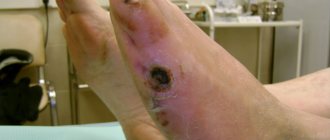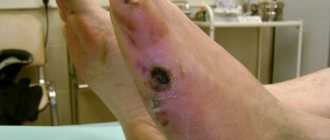- What is atherosclerosis of the lower extremity vessels?
- Symptoms of the disease
- Risk factors
- Stages of development of atherosclerosis of the lower extremities
- Diagnostics
- Treatment
- Conservative treatment
- Surgical techniques
- Possible consequences and prevention
- Popular questions
Obliterating atherosclerosis (OA) of the arteries of the lower extremities
is a chronic vascular disease, which is based on lipid metabolism disorders, leading to the formation of atherosclerotic plaques, thickening of arterial walls and a decrease in the vascular lumen. As a result, ischemia develops - insufficient oxygen supply to cells and tissues.
Most often the popliteal, femoral and tibial arteries are involved in the pathological process.
OA of the arteries of the lower extremities is in first place among diseases of the peripheral arteries of atherosclerotic origin. According to literature data, obliterating arterial diseases account for about 16% of all vascular diseases Source: Podrezenko E.S. The influence of risk factors on the development of obliterating atherosclerosis of the vessels of the lower extremities / E.S. Podrezenko, S.S. Dunaevskaya // Health is the basis of human potential: problems and ways to solve them. - 2012. - pp. 576-578. .
Symptoms of atherosclerosis of leg vessels
The development of the disease occurs gradually and in the first stages there may be nothing to show for it. Subsequently, the patient develops pain in the lower extremities, especially with prolonged walking, and a feeling of numbness in the feet. A decrease in temperature is felt on the legs, pallor and cyanosis are visible, and cramps occur. Over time, a person develops intermittent claudication and trophic changes occur in the form of delamination of nails and the formation of ulcers on the fingers and heels.
- with atherosclerosis, the patient may feel and observe the following:
- muscle pain in the legs, in the later stages even the feet hurt, and the pain cannot be relieved with painkillers;
- limited mobility of the affected leg;
- pain along the affected artery - first during physical activity, then at rest;
- intermittent claudication - after walking some distance, a person is forced to stand up and give his legs a rest, and then he moves on until the next attack of weakness;
- tingling, numbness in the affected area;
- thickening of nails;
- loss or slow growth of hair on the legs;
- paleness when raising the legs and sharp redness when lowering them;
- rapid freezing of feet;
- sores on the skin;
- purple fingers;
- absence of pulsation in the affected artery;
- areas of darkening on the skin are signs of the onset of gangrene in advanced stages;
- coldness of the skin of the leg;
- reduction in the mass and volume of the muscles of the thighs and legs.
At the beginning of the disease, as a rule, one limb suffers, then the process becomes symmetrical - this is a signal that the arteries are affected on both sides. An objective examination reveals the absence of pulsation in the popliteal fossa, thigh and ankle.
Clinic and main symptoms of the disease
The appearance of clinical signs is associated with a narrowing of the vessel lumen by more than 75%. Most often, the pathological process is localized in the lower abdominal aorta (below the origin of the renal arteries): 33% - aortoiliac segment, 66% - femoropopliteal.
The emergence of an atherosclerotic plaque with the formation of fibrosis (dense connective tissue) can be considered as an adaptation mechanism in response to trauma and aseptic inflammation of the inner lining due to the strong blood flow in the main arteries.
Typical signs of lower extremity lesions
The symptoms of the disease are caused by impaired blood delivery through the affected vessels to the muscles and nerve fibers.
The most characteristic symptoms of atherosclerosis of the vessels of the lower extremities:
- decreased tolerance to physical activity (fatigue when walking);
- intermittent claudication is a specific symptom that is characterized by the appearance of intense pain (burning) in the leg during physical activity, the need to stop and rest;
- neuropathies arise due to impaired nutrition of nerve fibers and are felt by goosebumps, numbness, and convulsions;
- change in skin color (pallor) of the legs, local decrease in temperature;
- thinning of the layer of subcutaneous fatty tissue, muscle atrophy (the volume of the limbs differs from each other with unilateral lesions);
- atrophy of hair follicles (hair on the legs becomes thin, brittle, and falls out over time);
- hyperkeratosis of the skin of the feet and nails.
The severity of symptoms is determined by the level, extent and degree of narrowing (stenosis). In addition, the presence of concomitant aggravating factors (diabetes mellitus, smoking, old age) worsens the prognosis for the patient’s life and health.
Manifestations of the disease in older people: what are the features?
The diagnosis is more often made in men, since the fairer sex has a protective effect of estrogen before menopause, which prevents the development of atherosclerosis. In addition, pathology is more often diagnosed in older people due to the depletion of adaptive and compensatory mechanisms. Features of atherosclerosis of the lower extremities in such patients are:
- slow progression of symptoms due to damage to nerve fibers;
- high intensity of pain syndrome (the reason is that the collateral arteries, which provide the minimum necessary blood flow in the tissues, no longer grow);
- systemic disorders: weight loss, exhaustion, mental status disorders;
- progressive muscle atrophy;
- frequent ulcers that cannot be treated conservatively;
- high risk of complications (in 30% of cases): gangrene, septic conditions.
Additional chronic pathologies of the respiratory system, heart, and kidneys complicate diagnosis and selection of effective treatment.
Amputation of the lower limb is prescribed in 45% of cases in elderly patients, which leads to disability and a deterioration in their quality of life.
Risk factors
The development of OA is based on the following most significant risk factors, the degree of influence of which can be different Sources: 1. Kuznetsov M.R. Basic principles of diagnosis and treatment of obliterating atherosclerosis of the arteries of the lower extremities / M.R. Kuznetsov // General medicine. - 2008. - No. 1. - P. 3-8. 2. Podrezenko E.S. The influence of risk factors on the development of obliterating atherosclerosis of the vessels of the lower extremities / E.S. Podrezenko, S.S. Dunaevskaya // Health is the basis of human potential: problems and ways to solve them. - 2012. - pp. 576-578. 3. Fattakhov V.V. Obliterating atherosclerosis of the lower extremities in the practice of a polyclinic surgeon / V.V. Fattakhov // Practical medicine. - 2010. - No. 2 (41). — P. 126-130. :
- male gender (men get sick 10 times more often);
- age (over 40 years);
- poor nutrition;
- overweight (obesity);
- smoking tobacco;
- hypokinesia (insufficient motor activity);
- hypofunction of the thyroid and gonads;
- heredity;
- some concomitant diseases (diabetes mellitus, coronary heart disease, heart rhythm disorders, lipid and carbohydrate metabolism, hypertension);
- exposure to adverse environmental factors.
Treatment and diagnosis of the disease: how to solve the problem of atherosclerosis
The main reason for the development of the pathology is not fully understood, so doctors identify a number of predisposing and provoking factors. Therapy of atherosclerosis involves a complex effect on:
- risk factors (obesity, smoking, diabetes compensation);
- pathogenesis of the disease (expansion of the lumen, improvement of blood properties);
- anesthesia;
- secondary prevention of complications.
Who treats the pathology and who to contact
To diagnose atherosclerosis when identifying signs of impaired blood supply in the lower extremities, consultation with the following specialists is necessary:
- cardiologist;
- cardiovascular surgeon for differential diagnosis with pathologies of the venous bed, endarteritis, thromboangitis;
- X-ray endovascular surgeon and interventional radiologist - specialists who carry out contrast methods for diagnosing pathology;
- endocrinologist - in the presence of concomitant diabetes mellitus.
Treatment of atherosclerosis of the lower extremities is carried out after determining the main causes of disorders in each patient, indications and contraindications for the prescription of drug therapy or surgical interventions.
What research do you need to do first?
A general clinical examination by a specialist includes:
- Assessment of pulse in the arteries of the lower limb. The level of occlusion is determined by the upstream area: if there is no pulsation in the femoral artery, the aortoiliac segment is affected, the popliteal segment is affected - the femoral one.
- Auscultation - a systolic murmur is detected over the affected area.
- Functional tests of Oppel, Panchenko (lost their diagnostic value).
The paraclinical research methods and changes required for atherosclerotic lesions are presented in the table:
| Method | Characteristic signs |
| Measurement of the ankle-brachial index (the ratio of blood pressure in the upper and lower extremities, normal -1) | Reduction to 0.7 and below, depending on the degree |
| Ultrasound Doppler examination (USDG) |
|
| X-ray contrast angiography |
|
| Blood chemistry |
|
Additional methods include determining the level of homocysteine: the higher the concentration of the latter, the higher the risk of disease.
Drugs for treatment: what medications are prescribed for atherosclerosis of the lower extremities
Conservative therapy for atherosclerosis is carried out at stages 1-2 of the disease in the absence of indications for surgical intervention. The basic principles of treatment and the groups of drugs used are presented in the table.
| Action | Group of drugs | Means and doses |
| Lipid-lowering | Statins |
|
| Homocysteine-lowering |
| |
| Improving the rheological properties of blood | Antiplatelet agents |
|
| Peripheral vasodilators |
| |
| Elimination of vasospasm | Myotropic antispasmodics |
|
| Prostaglandin analogues |
|
A prerequisite for effective treatment is compensation for other diseases (diabetes mellitus, pathologies of the respiratory system, liver and kidneys).
How to relieve pain
The mechanism of complaints is associated with impaired blood flow and the development of aseptic inflammation, therefore symptomatic treatment of atherosclerosis involves pain relief with non-steroidal drugs.
Most used medications:
"Nimid" - gel for topical use;- "Diclofenac" (in the form of 1% ointment or gel for topical use);
- "Dolobene-gel" (active substance - heparin) - is used to prevent recurrent thrombosis.
In a hospital setting, pain is controlled with local anesthetics or prostaglandin analogues for parenteral administration.
Modern surgical treatment methods
The effectiveness of conservative treatment has been proven only in the early stages of the process, so surgical intervention is used to radically restore blood flow. The most frequently used operations are presented in the table.
| Method | The essence of the intervention |
| Balloon angioplasty, stenting | The gold standard of treatment, which consists of endovascular insertion of a catheter, expansion of the lumen of the vessel using an inflating balloon and placement of a metal frame |
| Bypass surgery | Creation of “bypass” connections of the segment below the lesion with the area of normal blood flow |
| Endarterectomy | Removal of a blood clot from the lumen of the artery and the area of the affected inner lining |
| Resection with prosthetics | Isolation of a segment with atherosclerosis, replacement with a graft (synthetic or from the patient’s veins) |
| Sympathectomy | Removal of nerve ganglia (in open or laparoscopic surgery) to relieve vasospasm |
In case of necrosis or gangrene, amputation of the limb is required, depending on the level of damage: finger, ankle joint, knee.
Stages of development of atherosclerosis of the lower extremities
The most detailed is the modified classification of chronic arterial insufficiency of the lower extremities (CANF), which takes into account in detail the phenomena of critical limb ischemia, which is necessary when determining treatment tactics.
| Stage 1 | Muscle pain only during heavy physical activity (when walking over a distance of more than 1 km). Initial signs of stenosis appear - the skin turns pale, there is a feeling of goosebumps, it seems that the legs are always cold, fatigue quickly sets in when walking, excessive sweating is observed |
| Stage 2A | Feeling of fatigue and stiffness in the calf muscles, intermittent claudication after 200-1000 m |
| Stage 2B | Intermittent claudication in less than 200 m |
| Stage 3A | Intermittent claudication after a few steps or pain at rest when it is possible to keep the lower limb in a horizontal position for more than 2 hours |
| Stage 3B | Pain at rest, ischemic edema, inability to keep the lower limb in a horizontal position for 2 hours |
| Stage 4A | Gangrene of the fingers or part of the foot with the prospect of maintaining the supporting function of the limb |
| Stage 4B | Extensive necrotic changes in the limb without the possibility of maintaining its supporting function |
Symptoms
Obliterating atherosclerosis of the lower extremities has its own symptoms, which are characteristic of this particular disease. Typically, the symptoms of atherosclerosis of the lower extremities intensify in each subsequent stage.
- Signs of the disease at stages 1 and 2 manifest themselves in the form of pain in the calf muscles when walking, turning into periodic lameness.
- The disease progresses and at stage 3 pain appears at rest, especially during sleep. At the same time, patients feel numbness and chilliness in their legs.
- If you do not pay due attention to the symptoms of vascular diseases in the legs, over time you risk noticing trophic ulcers on the skin (stage 4).
Diagnostics
There is a standard diagnostic program for this disease:
- Ultrasound of vessels of the lower extremities (duplex and Doppler scanning);
- coagulogram (determination of the blood coagulation system);
- determination of cholesterol and LDL levels in the blood;
- leg arteriography;
- establishment of pulsation in peripheral arteries;
- MR, MSCT angiography.
If prescribed by a doctor, MRI and CT scans with contrast and rheovasography can be performed.
To make a timely diagnosis of atherosclerosis of the vessels of the lower extremities, consultation with a vascular surgeon or phlebologist and a number of diagnostic measures are necessary.
Due to the systemic nature of the atherosclerotic process, patients with OA of the lower extremities often experience combined damage to various arterial basins, therefore, in such patients, an integral part of instrumental diagnosis is the study of extracranial and coronary arteries. Identification of pathology in them may require a change in treatment tactics or the order of surgical interventions Source: Kuznetsov M.R. Basic principles of diagnosis and treatment of obliterating atherosclerosis of the arteries of the lower extremities / M.R. Kuznetsov // General medicine. - 2008. - No. 1. - P. 3-8. .
Causes
The main cause of the disease is systemic atherosclerosis. The formation of cholesterol plaques on the walls of blood vessels of the lower extremities is associated with the same pathological mechanisms that cause vascular damage in any other place.
Factors in the development of atherosclerosis:
- dyslipidemia – an imbalance in the content of fats (triglycerides and lipoproteins) in the blood;
- weakness and loss of firmness and elasticity of the vessel wall;
- disruption of cellular metabolism;
- genetic predisposition.
Risk factors for developing pathology:
- gender – men suffer from atherosclerosis several times more often than women;
- age – the disease usually begins to progress after 40 years;
- smoking - nicotine has a vasoconstrictor property and negatively affects the condition of the walls of blood vessels;
- overweight;
- unhealthy diet – a large amount of fat in the diet worsens lipid metabolism and contributes to the formation of cholesterol deposits;
- sedentary lifestyle;
- hormonal disorders;
- unfavorable environmental conditions.
Source: freepic.diller / ru.freepik.com
People with chronic diseases are predisposed to obliterating atherosclerosis: hypertension, endocrine disorders, ischemia and a number of others.
Treatment of atherosclerosis of the vessels of the lower extremities
The approach to treatment is determined depending on the stage of the disease and is primarily about choosing the right regimen. It is necessary to adhere to a diet limiting fried and fatty foods, eliminating smoking and alcohol, as well as combating excess weight. The patient should follow a walking and physical activity regimen, choose comfortable and spacious shoes, and treat even the smallest injuries on the skin of the lower extremities. Treatment of concomitant chronic diseases is mandatory.
Medicinal methods include anticoagulants, antiplatelet drugs, agents that improve blood microcirculation, vasodilators, and physiotherapeutic procedures.
In severe cases, surgical treatment may be necessary.
General recommendations:
- normalize weight;
- follow a diet with low cholesterol;
- give up alcohol and smoking;
- wear shoes that fit;
- do not overcool your feet;
- even minor injuries should be carefully treated and treated;
- trim nails carefully without damaging soft tissues;
- engage in moderate physical activity - walking, swimming, cycling or exercising on an exercise bike.
Treatment methods
The doctor’s task is to identify and eliminate the root cause of the disease, relieve symptoms, restore vascular patency and prevent complications. Treatment tactics depend on the stage, spread and nature of the disease. Conservative therapy includes:
- drug treatment (beta blockers, drugs to reduce erythrocyte aggregation, antispasmodics, vitamins, analgesics, anticoagulants, thrombolytics, synthetic analogues of prostaglandins and vascular growth factors, etc.);
- non-drug methods - physiotherapy, ozone therapy, balneological procedures (various baths, mud), laser irradiation of blood, etc.
An indispensable condition for maintaining the supporting function of the legs is a complete cessation of smoking (!), adjustments to lifestyle and nutrition, and dosed physical activity.
Surgical treatment of grade 2–3 obliterating atherosclerosis is aimed at restoring the patency of the damaged artery or replacing it with a prosthesis. Depending on the indications, the following is carried out:
- balloon angioplasty - expansion of the arterial lumen with a special balloon installed in its cavity;
- bypass - formation of a bypass channel to restore normal blood flow;
- artery stenting - the vascular lumen is expanded with the help of a stent;
- endarterectomy - excision of a damaged fragment of the internal lining of an artery;
- prosthetics - replacement of a damaged vessel with a prosthesis.
In the absence of effectiveness of the treatment and an increase in ischemia of the limb with progressive gangrene, the leg is amputated to the optimal level, taking into account the boundaries of ischemic disorders.
You have questions? We will be happy to answer any questions Coordinator Tatyana
Treating atherosclerosis
- Shishkin A.A.
- Volkov A.M.
- Kabirov A.V.
- Baranov V.S.
Shishkin Andrey Andreevich
Candidate of Medical Sciences. Surgeon, proctologist, phlebologist at SM-Clinic. Proficient in all modern methods of conservative and surgical treatment of diseases of the veins of the lower extremities (including sclerotherapy, EVLT - endovasal laser coagulation, traditional phlebectomy)
Read moreVolkov Anton Maksimovich
Phlebologist, surgeon at SM-Clinic. Performs operations with a modern proprietary method of treating varicose veins using a laser (modified endovenous laser coagulation. M-EVLC).
Surgical treatment of varicose veins of any complexity (phlebectomy, miniphlebectomy) More detailsKabirov Alexander Vitalievich
Cardiovascular surgeon at SM-Clinic. Candidate of Medical Sciences Proficient in all modern methods of conservative and surgical treatment of diseases of the veins of the lower extremities (including sclerotherapy, EVLT - endovasal laser coagulation, traditional phlebectomy)
More detailsBaranov Vladimir Sergeevich
Cardiovascular surgeon at SM-Clinic. Candidate of Medical Sciences Treats lower varicose veins using non-surgical and surgical methods (aesthetic sclerotherapy, ECHO sclerotherapy, stem sclerotherapy, phlebectomy, miniphlebectomy, EVLT).
More details
Diagnosis of atherosclerosis
The diagnosis is based primarily on the results of laboratory tests and data from instrumental research methods.
A conversation with a patient only allows us to identify risk factors for the development of diseases and, together with an examination, as well as consultation with other specialists, suggest which organs have already been affected by the disease. Diagnosis of atherosclerosis necessarily includes:
- Blood chemistry.
- Ultrasound of the heart and blood vessels.
- Electrocardiography.
A high predisposition to the development of the disease is indicated by changes such as an increase in the concentration of total cholesterol, triglycerides, low- and very low-density lipoproteins, and a decrease in the amount of high-density lipoproteins.
Innovative risk factors for atherosclerosis include C-reactive protein (CRP), apolipoproteins A1 (apoA1) and B-100 (apoB), some polymorphisms of endothelial synthase genes (NOS3G894T, NOS3T(-786)C) and blood coagulation factors FV and FII. To obtain accurate results of a blood test for atherosclerosis, three days before the test you should give up fatty, cholesterol-rich foods, and 8-10 hours before, eat nothing at all and drink a lot of liquid. 30 minutes before the test, you should avoid strong emotional stress, stress, and do not smoke.
Echocardiography clearly shows signs of atherosclerosis of the heart valves and aorta. According to indications, ultrasound scanning of the brachiocephalic, transcranial, and arterial vessels of the lower extremities is also performed.
Reflects disturbances in heart rhythm and electrical conductivity of the organ. Exercise testing may be performed to detect exertional angina.
The standard list of laboratory tests also includes a general clinical blood test and a general urinalysis.
Additionally, for the purpose of differential diagnosis, blood tests for the level of fibrinogen, homocysteine, antibodies to cardiolipin (IgG and IgM), and lupus anticoagulant may be recommended. To visualize atherosclerotic plaques, according to indications, angiography is used - an X-ray examination with the introduction of a contrast agent. In case of preparation for surgery on the heart vessels, coronary angiography is performed.
The “gold standard” for diagnosing pathological changes in the arteries of the brain and parenchymal organs is spiral computed tomography with contrast.
Often such patients are recommended to consult an ophthalmologist. Fundus ophthalmoscopy reveals signs of atherosclerotic damage to small retinal vessels.
Conservative treatment
The patient may be prescribed various medications:
- prevent the formation of blood clots, prevent stroke and heart attack;
- increasing physical activity, improving blood flow in the lower extremities;
- antiplatelet drugs that lower blood cholesterol levels;
- anticoagulants, which prevent blood clotting in blood vessels and prevent blood clots;
- antispasmodics to relieve pain and spasms;
- antimicrobial ointments that need to be used to treat trophic ulcers;
- medications that promote better tissue nutrition;
- vasodilators;
- vitamins.
Also, as part of conservative therapy, physiotherapy is performed - electrophoresis with novocaine, darsonvalization, hyperbaric oxygenation.
Prevention of atherosclerosis
For patients with a family history and age-related predisposition, a screening examination is recommended to determine the risk of developing cardiovascular pathology.
It aims to detect laboratory and genetic markers of the disease. Prevention of atherosclerosis includes weight control, proper nutrition, sufficient physical activity, giving up bad habits, and timely treatment of chronic diseases.
Author:
Pugonina Tatyana Alekseevna, Therapist
Surgical techniques
Surgery is a last resort and is usually prescribed for severe ischemia and very severe complications. Nowadays, different types of surgical interventions are performed. Some involve a day hospital, some require a long-term hospital stay under observation. Patient rehabilitation plans and post-operative care vary. Our doctors advise patients in detail on all aspects related to surgical intervention and carefully monitor their health in the pre- and postoperative period.
Surgical treatment of atherosclerosis of the lower extremities:
- bypass surgery - an additional “bypass” path for blood flow is created around the area of narrowing of the artery;
- stenting - a special tubular spacer is placed in the affected vessel, which ensures the required diameter of the artery;
- balloon angioplasty - similar to stenting, only a balloon is inserted into the vessel cavity rather than a spacer, which expands its lumen;
- autodermoplasty - if trophic ulcers are poorly treated conservatively, they are operated on and covered with the patient’s own skin;
- endarterectomy - removal of the affected part of the artery in which the atherosclerotic plaque is located;
- prosthetics – replacement of the affected vessel with the patient’s own vein, taken from another place, or with a synthetic prosthesis;
- amputation - prescribed in severe cases when gangrene occurs, after which prosthetics are performed.
In 75-85% of cases, after surgery, blood circulation is completely restored for an average of 5-8 years.
Indications for surgery:
- an aneurysm that may rupture;
- chronic ischemia of critical stage;
- hemodynamically significant carotid artery stenosis or plaque accompanied by symptoms of cerebral ischemia;
- decompensation of blood circulation in the leg due to embolism, trauma, thrombosis.
Contraindications to surgical treatment:
- wet gangrene with sepsis;
- severe disruption of vital organs - renal and liver failure, circulatory disorders in the brain, myocardial infarction, heart failure, etc.
More about the disease
Periodic pain in the legs is often attributed to fatigue.
However, this minor symptom, especially in older people, may indicate a serious problem with the blood vessels. This is one of the most insidious pathologies, which does not manifest itself for a long time, but when the first signs appear, it begins to progress very quickly. People over 50 years of age suffer from this disease, although younger patients are also found. The essence of the pathology is damage to the internal walls of blood vessels by atherosclerotic plaques, due to which a gradual narrowing of the vascular lumen occurs, followed by complete blockage and cessation of blood flow. The disease has the following stages:
- I - preclinical - manifested by pain in the legs during long walking or physical activity, there are no other symptoms;
- II - discomfort and heaviness occurs even after a short walk;
- III - you can walk no more than 50 m painlessly, pain in the legs bothers you at rest, at night;
- IV - accompanied by the formation of trophic ulcers, necrosis and gangrene.
Without treatment, the patient will experience loss of supporting function of the legs and disability, since gangrene requires amputation. Meanwhile, at the initial stage, the pathology responds well to treatment, so if alarm bells appear, do not delay, make an appointment with a doctor.
Possible risks associated with the disease
The disease is insidious in that it is impossible to predict its course and symptoms. Approximately 20% of patients over 65 years of age, having severe plaques, do not feel any discomfort. The seriousness of the progressive course of OA ANC is also due to the fact that after the appearance of the first symptoms, 10-40% of patients develop gangrene within 3-5 years, which leads to amputation of a limb or death Source: Kazantsev A.V. A new approach to surgical tactics for obliterating atherosclerosis of the arteries of the lower extremities / A.V. Kazantsev, E.A. Korymasov // Saratov Medical Scientific Journal. - 2010. - T. 6. - No. 4. - P. 850-856. .
Atherosclerosis can be complicated by arterial thrombosis. This complication, if not immediately sought by a doctor, leads to loss of a limb or embolism of other arteries. If the clot detaches and enters the coronary artery, a myocardial infarction may develop, and if it migrates to the carotid artery, a stroke may occur.
Complications
- In the later stages of atherosclerosis of the arteries of the lower extremities, poorly healing wounds appear on the skin and the slightest damage causes discomfort. Eventually necrosis of the limb (gangrene) develops, and this is fraught with amputation.
- Fragments of plaques in blood vessels can separate and form blood clots, which migrate through the bloodstream, clogging the vessels.
- As a result of atherosclerosis, the lining of the arteries undergoes changes and becomes susceptible to dissection. Weakened vessel walls are damaged under the influence of increased blood pressure: for example, dissecting aortic aneurysm is associated with sclerotic processes in peripheral vessels. This disease is deadly.
Prevention methods
For prevention purposes, you need to start controlling the levels of lipids, sugar and cholesterol in the blood as early as possible. Even with a slight increase in numbers relative to the norm, you should consult a doctor. It is also recommended to regularly do ultrasound of the lower extremities - once every 1-2 years.
It is important to watch your diet, because the reason for the increase in “bad” cholesterol in the blood is the saturated fats that we consume in food. These are products of animal origin - fatty meat, lard, butter. There is a lot of cholesterol in eggs, or rather in the yolks. All these products should be consumed in the smallest possible quantities.
| Name of service (price list incomplete) | Price, rub.) | In installments* |
| Appointment (examination, consultation) with a cardiovascular surgeon, primary, therapeutic and diagnostic, outpatient | 1 750 | — |
| Program “Risk of atherosclerosis and ischemic heart disease, predisposition to dyslipidemia” | 19 000 | — |
* You can read more about the conditions here - Treatment on credit or in installments.
Prognosis and prevention
Source: PhotoMIX Company: Pexels
The effectiveness of treatment and the overall prognosis for obliterating atherosclerosis depend on the time of initiation of therapy, the degree of arterial damage and the presence of concomitant pathologies. Therapy is particularly difficult when other vessels, cerebral or coronary, are simultaneously affected.
The most dangerous complication of the disease is gangrene, which has a high probability of death. Its development can only be prevented by emergency amputation of the affected limb.
Prevention measures are aimed at reducing the risk of developing atherosclerosis and include the following recommendations:
- normalize your diet and give up high-fat foods;
- do not smoke or drink alcoholic beverages;
- devote time to moderate physical activity, such as swimming, cycling or even just walking;
- keep your feet clean;
- wear comfortable shoes with low heels;
- Avoid injuries and cuts to the skin on your legs.
Timely treatment can stop the development of the pathological process and significantly improve the patient’s quality of life.
Doppler ultrasound
Ultrasound examination is the most common diagnostic method. This study is the first step towards studying human vascular diseases. Based on the ultrasound results, a further diagnostic and treatment plan is built.
Important: Smoking is prohibited before the ultrasound procedure. Smoking causes vasoconstriction, which leads to incorrect test results. And in general, before any diagnosis and testing, you should ask your doctor in advance how to prepare. This will help avoid unpleasant situations at the reception.
This is approximately how an ultrasound of the foot goes. Source: Vascular Online Training VOT / YouTube
Using ultrasound, it is possible to examine all changes in blood vessels, the degree of their narrowing or the presence of stenosis. Determine the localization and duration of atherosclerotic processes.
Treatment
Source: javi_indy / ru.freepik.com
Treatment depends on the stage of development of the disease, the area of the affected areas and their location. There are two main areas of treatment:
- Conservative treatment. Aimed at eliminating risk factors and normalizing blood circulation using a number of medications;
- Surgery. Indicated for critical ischemia of the lower extremities.
Medicines are represented by the following groups:
- Antispasmodics. These are substances that reduce smooth muscle tone. When exposed to blood vessels, they cause their expansion;
- Disaggregants. Reduce the rate of blood clot formation by inhibiting platelet aggregation;
- Antiatherosclerotic agents. Drugs that regulate the amount of lipids in the blood. Effective after surgical operations in the rehabilitation period as prophylactic agents;
- Metabolic drugs. Used as an auxiliary element in treatment. Helps improve metabolic processes (transport of oxygen, glucose, enzyme activity);
- Angioprotectors. Substances that reduce vascular permeability and improve blood microcirculation.
For atherosclerosis of the first and second stages, it is recommended to engage in training walking. The patient should walk on a level surface at a calm pace until pain appears. After this, without stopping to rest, you must switch to a slow step and continue moving. Gradually the pain disappears and the patient can move at an average pace again.
In general, the situation is reminiscent of that stage of growing up when you need to learn to walk, only now - all over again. It is recommended to walk at least 3 km in this way per approach. This exercise will not cure the disease, but it will help significantly increase the distance a person can walk. You will definitely be able to go for a walk, to the store or from transport to your apartment.








